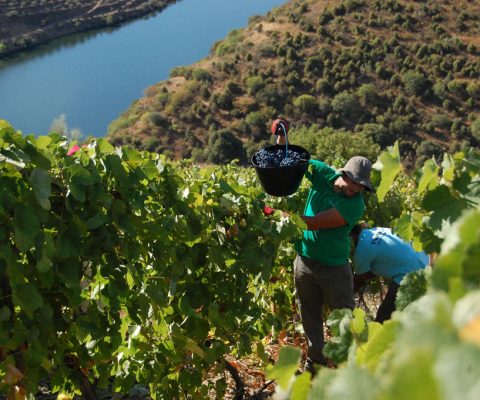At Quinta do Monte Xisto, all of our steps, methods or strategies in viticulture are implemented with the purpose of optimally adapting the vine to the Douro climate and soil. We do this in an organic way, in a continuous learning process. We try to learn from the wisdom of our elders, following principles of local, ancestral viticulture practises, and combining them with current knowledge.
Diversity (bio)
«Diversity (from the Latin word diversitate) is linked to the concepts of difference, opposition, plurality, multiplicity, different angles of vision or approach, heterogeneity, communion of contraries, intersection of differences or mutual tolerance.»
We value greatly the concept of diversity and that is why we practice organic farming at Quinta do Monte Xisto, since the beginning of its plantation. This type of farming consists not only in not using chemical products but also in preserving and promoting (bio) diversity. We have a significant area of woodland that we care for, composed mostly of junipers, holm-oaks, and terebinths. We also have an olive grove where we produce our olive oil, almond-trees spread throughout the Quinta, and a small orange grove – a cultural mosaic.
Organic Farming
«Organic farming appeared in the shape of a movement that opposes industrial farming and intends to reintegrate human activities into the ecosystems’ carrying capacity. It is the most widely known and recognized current of sustainable agriculture. Organic farming does not use synthetic chemicals, such as synthetic fertilizers and pesticides, and it gives particular importance to maintaining soil fertility.»
The plant treats the plant
It is better to be safe than sorry. We make infusions of several plants which may be sprayed on the vineyard or incorporated into the soil with the purpose of preventing diseases, protecting the vines against the heat or serving as fertilizers. This type of practises contributes to the Quinta’s self-sufficiency, working towards obtaining a natural dynamic of needs. Biodynamic agriculture complements organic farming.
Biodynamic Agriculture
«Biodynamic agriculture began with an agricultural course developed by Rudolf Steiner in 1924. Farms are considered organisms, where one part relies on the other, making it necessary to use holistic management to achieve the farm’s integrity. Therefore, recycling and reusing the farm’s resources becomes especially relevant, which is why vegetable and animal production are usually associated. Biodynamic agriculture emphasizes the power of preparations (plant, mineral and excrement-based), and the coordination of certain activities according to the alignment of the stars (mostly the sun and the moon) to improve the health, productivity and nutritional value of the cultivars.»
Soil
For each vine to retain as much water as possible in winter, and to protect the vines against the heat in summer, we work the soil like they used to do in the Douro – the cava/descava method. After the harvest, we make holes around the vine to collect rainwater in winter and allow the leaves to accumulate, providing water and nourishment. Also, at this time, in the holes, we might incorporate plants into the soil, as fertilizer. In spring, we replace the soil at the foot of the vines, protecting them against the heat.
Harvest
Harvest is scheduled mostly by observing the vine and tasting the grapes. High temperatures, the height of summer, schist powder in the air. A taste here, a taste there, up the hill, down the hill… what do you think? An open discussion between father and sons, an incisive ray of sunlight draws doubts in the air. The Quinta do Monte Xisto wine has the peculiarity of being made through the blend of the grape tasting, almost row by row. Depending on the years, we get more freshness from the north side or more maturation from the south side. Also, in each of these exposures, we explore the different altitudes. Jumping from parcel to parcel, the harvest takes place, grapes are collected in 20 kg boxes and fly to the lagar.
















